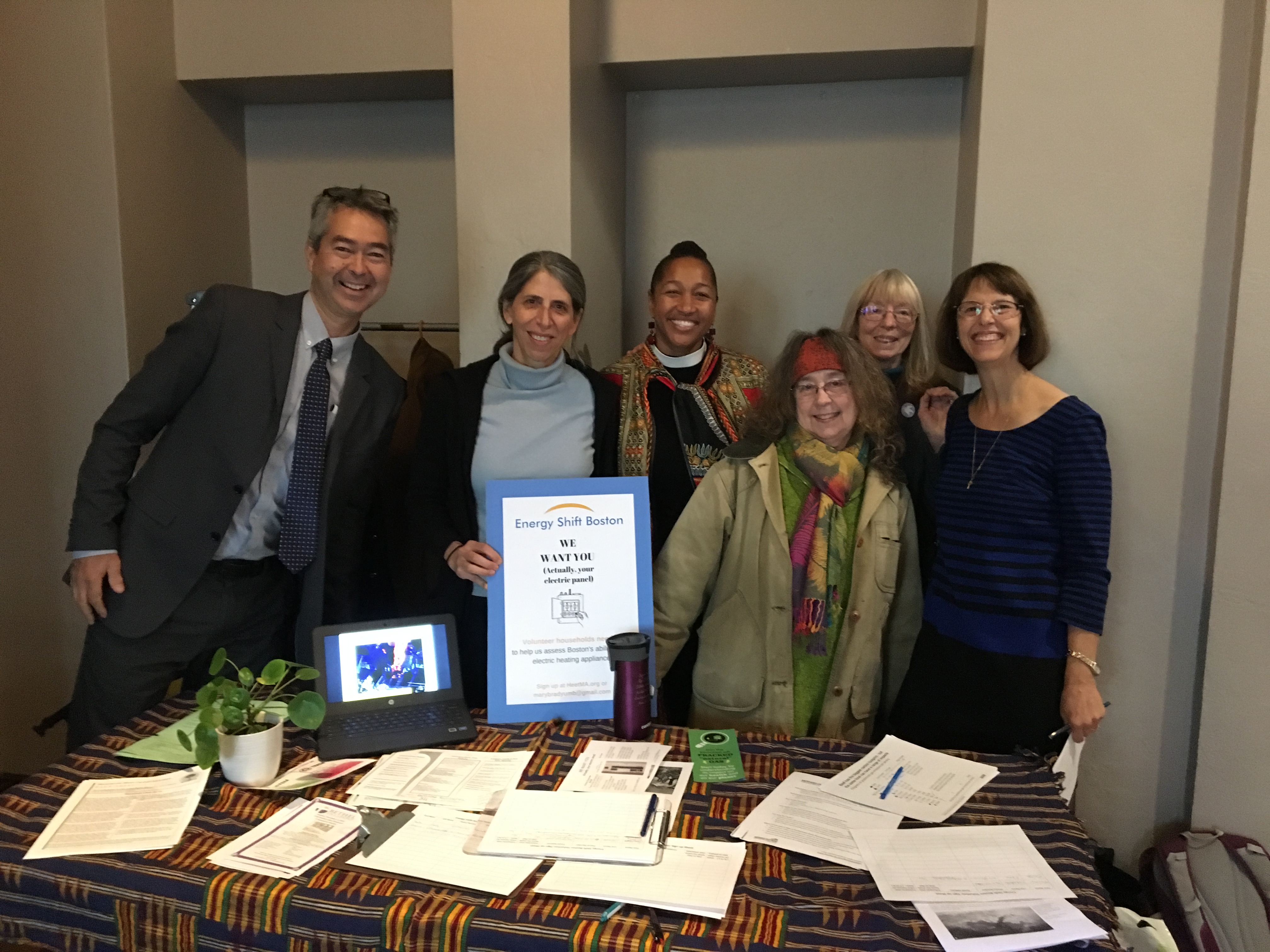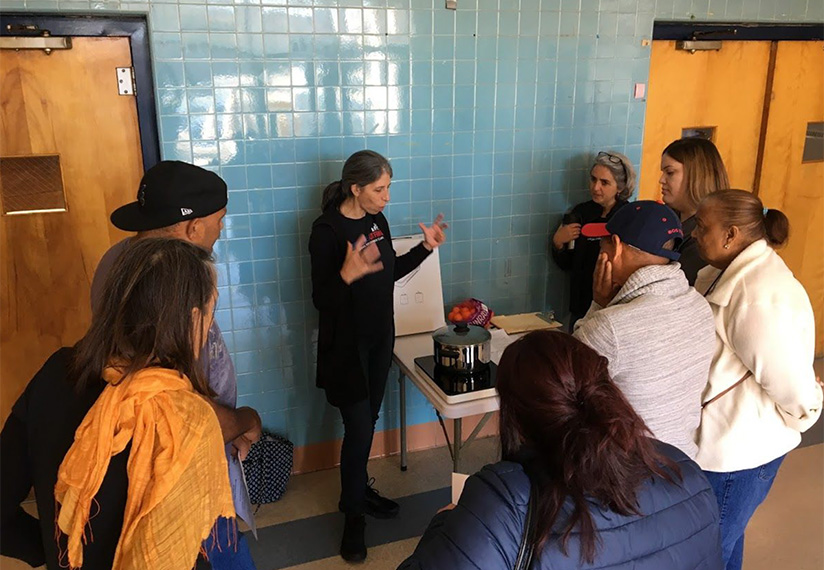December 17, 2019
Coffee with the Cohort: Meet From Energy Security to Energy Shift
Alicia Deluga
I sat down with Nathan Phillips and Mary Brady from Sasaki Foundation Design Grants project From Energy Security to Energy Shift, in Boston & Beyond. Their project will test and develop methods for Boston and other municipalities to effectively inventory and build household electric capacity across diverse housing stock and communities, applying lessons learned from last fall’s Merrimack Valley gas disaster.
Alicia: Thanks for taking some time to chat with me today! To start, can you tell us a little bit more about each of your roles on the project?
Nathan: Sure. I would consider myself the project coordinator. I’m affiliated with Home Energy Efficiency Team (HEET), and I’m also an ecologist and professor at Boston University. I’ve been working on gas leak issues for a decade, and the Merrimack Valley gas disaster truly changed so much for me in terms of my work and my outlook. I wanted to take lessons learned from this and make a difference.
Mary: My role on the project is really hands on. I help identify people and places that can be involved with this work, and I reach out to the community and create ways for members of the community to connect with the project. I’m also a resident of District 6 (Jamaica Plain), which is where his project is being piloted.
If I could, I’d like to go into a little more detail. The notion that gas leaks continue to get in the way of our lives is just unimaginable. We haven’t been able to take big stands against gas leaks to stop them from happening. What I love about this project is it brings us in contact with the community and others, where our individual impact can interconnect to make a difference. Our goal was to begin to identify a small number of people who would like to be involved with the project, where we’d be able to visit people’s homes and analyze their electric panels. We officially began recruiting at a Jamaica Plain neighborhood council meeting on October 22, and have been to two events since then. Our goal was to recruit 100 homes between now and May, and we are already at 74 homes.

The team at Bethel AME Church, Jamaica Plain, MA.
These are people, not just households, and when given the opportunity to step up and do something that matters, they take the opportunity and run with it. We were at the Bethel AME Church in Boston, which is a predominantly African-American congregation, and at the end of the service the minister stopped and provided opportunities for members to jump in and take part; there was not enough time to take names down quickly, and people waited around to make sure they signed up. Our team is going to take pictures of folks’ electric panels. One woman came up to me and said, “I hope you can find it!” It was incredible.
Alicia: That is incredible. It must feel so rewarding, because you’re setting these aspirational yet attainable goals, and for you to make so much progress already is testament to the power of your work. So, you’ve answered this a little bit already, but can you touch on this further—what is the biggest inspiration behind your project? What was the catalyst for you to personally invest your time, expertise, and more, and how did everything come about?
Nathan: In the days, weeks, and months after September 13, 2018, seeing the resilience and strength of the people there who were making it through the most difficult circumstances and being there for each other was a huge inspiration for me. Also, the outpouring of support outside of Merrimack Valley was very inspirational: people were providing donations for cooktops, IKEA stepped up in a big way and made a huge donation of cooktops directly to those affected. All of this became very inspiring.
As we saw things that did and did not play out, there were so many lessons learned emerging. I remember talking with Ania Camargo, another member of our team, as everything was coming to a close and gas was being turned back on, and I remember us discussing that if we do not learn lessons from this and it goes back to business as usual and the way it was before, it would be devastating. We just did not want that to happen. We had to do something so communities could benefit from these lessons learned.
When the call for proposals for the Sasaki Foundation Design Grants came out, we saw this opportunity as a vehicle and platform for us to apply these lessons learned.
Alicia: And here you are today! We’re so happy to have you here. What would you say is one of your favorite parts of your work on this project?
Mary: I wanted to work on this project because I wanted to be part of a community. I wanted to extend a hand out to grab other people in the community who want to make a difference. I wanted to give people a way to help make a difference in a way they might not have been able to without this platform.
Nathan: I’m going to have to build on what Mary said before, that exemplifies almost a magical feeling. At the church service, I was sitting in the pews with Mary, Ania, and another one of our allies Susan, and thought, “how did I end up here in this pew listening to a service from Reverend Mariama White-Hammond,” and thought if it weren’t for our work here at the Sasaki Foundation and the deepening of the ties that this program has allowed us to do I wouldn’t be making this impact. I’m a natural scientist, and now I’m sitting in a pew listening to her sermon about weaving together Intergovernmental Panel on Climate Change (IPCC) climate reports, with what’s happening on our southern border, with concepts that I learned from her about the difference between ecological justice and environmental justice; so many factors are getting connected through this project that deepen and extend our ties in incredible ways.
Mary: Nathan and I had a quick exchange earlier; we’re both academics in different ways, and what this project is doing is melting the barriers and the silos that I have in my life between being an academic, a wife, a gardener, etc. My whole person is present in this work.
Alicia: I love that. This is all so synergistic with our work here at the Foundation and the firm. We talk about interdisciplinary approaches to work all the time, a concept Hideo Sasaki pioneered in design thinking years ago, and how it’s so crucial and important that so many perspectives are sitting around the table. I just love how that translates into your work as well.
Nathan: Certainly. This exists in academics as well—you do have people who understand and strive to cross those boundaries—and yet, we are going even beyond that. There is a public-facing aspect to the work we’re doing. The community engagement we’re doing goes beyond our inward-looking yet interdisciplinary work together. The fact that we’re reaching out to the community is taking this work that much further. That’s, of course, what Sasaki does too. So much of what we’re doing is in the invisible, buried, underground infrastructure and we really need to be able to engage with the community through visual communications, where we can lean on Sasaki for this.
Alicia: For sure. What are your aspirations for this project, both short-term and long-term? What is the impact that you hope your work will have on the community?

Empowering communities, Boston, MA.
Nathan: This project has the short-, immediate-, and long-term impact built in; one informs the other. Aspirationally, I see this project assisting the 351 cities and towns in Massachusetts, or at least assisting the communities on gas, to better prepare for disasters and ultimately get to carbon neutral by 2050. Our project could provide cities and towns with necessary steps to get municipalities to consider electrification of the building heating sector. This is definitely aspirational, but it feels great to make tangible moves in that direction. We believe that no one is doing this work yet in Massachusetts; there are big commitments and plans to do so, but the small steps aren’t being taken yet and we’re finding that is a huge opportunity for us to get involved.
Mary: And Nathan, let’s not leave the public awareness piece out, because by us going into people’s homes, we remind them that there is a path to overcoming disaster. For many folks, they are not as clear about the information, but once we go through their homes and emphasize what to look for, it helps folks be on board so when they go in their communities, when they participate in events, or even when they partake in political actions, they are able to speak up about it and be more informed from their own experience in their homes.
Alicia: Absolutely, and those people become your advocates; not only do they get to inform some of your work but they become a continuation of your work within the community. Finally, what are some of the various ways folks can get involved in your work now or in the future?
Mary: At a very concrete level, we’d love for folks to contact us. The level of immediate involvement depends on where they live. They could could come with us to look at homes, they could open their home to us to look at if they live in District 6, we could have conversations about their own district and how what we’re doing might contribute to the work their community is doing—the opportunities are endless.
Nathan: Agreed Mary. Also, this project is piloted in District 6, but we can imagine this scaling throughout Boston, the 351 cities and towns in Massachusetts leveraging the MassDEP’s emergency preparedness program, and more. Again, this is aspirational, but with our partnership with Mothers Out Front who have a local presence as well as a presence in California, Alabama, and more, there are already Taste the Future cooking demo house parties, which are part of our work. We can always be making connections, and there are always ways folks can become involved, as every bit helps in moving toward the goal of full electrification and fully carbon neutral by 2050.
If you’d like to connect with folks from the Energy Security to Energy Shift, in Boston & Beyond project, please send an email to energyshift@sasakifoundation.org.
